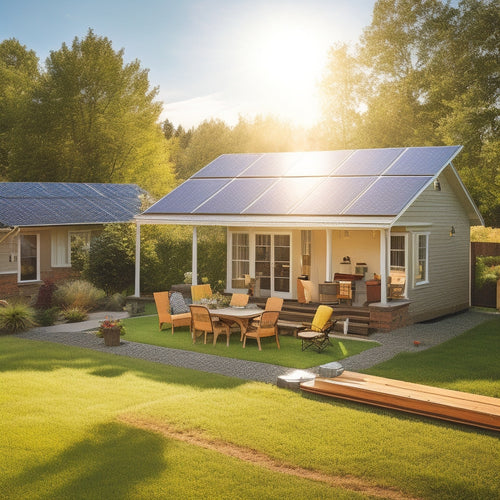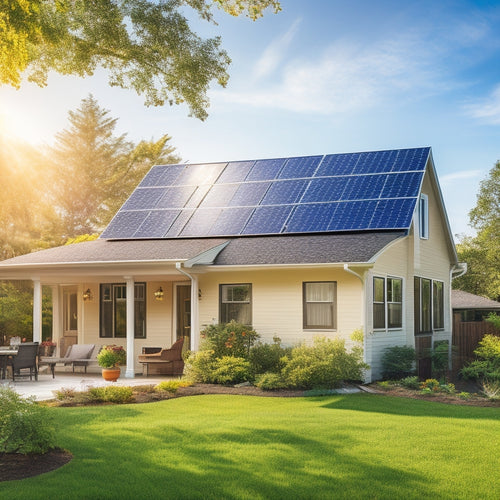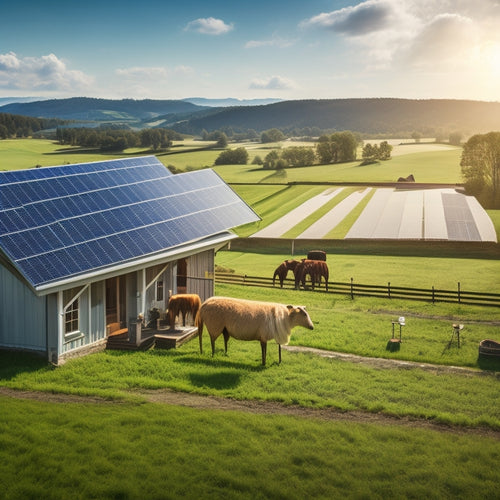
Installing Solar Arrays for Your Home
Share
You're taking a significant step towards reducing your carbon footprint and saving on energy costs by installing a solar array on your home. To get started, you'll want to assess your home's solar potential by evaluating its solar orientation, shading analysis, and ideal location for maximum sunlight. Next, choose the right solar panels based on panel efficiency ratings, types of solar cells, and your unique energy needs. Select a reputable installer with extensive experience, qualifications, and necessary licenses. As you maneuver through the installation process, understanding system components, roof preparation, and common challenges will be essential. Now, investigate the specifics of each step to guarantee a successful and efficient solar array installation.
Key Takeaways
- Assess your home's solar potential by evaluating solar orientation, conducting a shading analysis, and determining the best location for the solar array.
- Choose the right solar panels by considering panel efficiency ratings, types of solar cells, and your energy needs and available roof space.
- Select a reputable installer with extensive experience, necessary licenses, and certifications, and evaluate their insurance coverage and company policies.
- Ensure a successful installation by preparing your home's roof, understanding system components, and overcoming common installation challenges.
- Maintain your solar array through regular inspections, performance monitoring, and annual professional maintenance checks to ensure optimal energy production.
Assessing Your Home's Solar Potential
Installing Solar Arrays for Your Home
Assessing Your Home's Solar Potential
Most homes can benefit from solar power, but your home's unique characteristics play a significant role in determining its solar potential.
You'll need to evaluate your home's solar orientation, which refers to the direction your roof faces and how it affects the amount of sunlight it receives. South-facing roofs receive the most sunlight, making them ideal for solar arrays.
You'll also need to conduct a shading analysis to identify any obstructions that could reduce your system's energy output. This includes trees, buildings, and even chimneys or skylights on your own roof.
A shading analysis will help you determine the best location for your solar array and guarantee it receives maximum sunlight.
Choosing the Right Solar Panels
When selecting solar panels for your home, you'll need to contemplate key factors that impact their performance and lifespan.
You'll want to evaluate panel efficiency ratings, which measure how well they convert sunlight into electricity, as well as the types of solar cells used, such as monocrystalline or polycrystalline.
Additionally, you'll need to contemplate wattage and durability, including the panel's power output and its ability to withstand environmental stressors.
Panel Efficiency Ratings
Across various solar panel models, you'll find a significant range of efficiency ratings, which can directly impact the amount of electricity your system generates. Efficiency ratings measure a panel's ability to convert sunlight into usable energy. Higher efficiency ratings mean more energy conversion per unit area, resulting in more power output.
When choosing a solar panel, look for models with high efficiency ratings, typically ranging from 15% to 22%.
A higher efficiency rating also affects the panel lifespan. Since high-efficiency panels produce more power per unit area, they tend to degrade more slowly over time, resulting in a longer panel lifespan. This means you'll get more years of reliable energy production from your system.
When evaluating panel efficiency, consider your available roof space and energy needs. If you have limited space, high-efficiency panels may be the better choice to maximize energy production.
Types of Solar Cells
Installing Solar Arrays for Your Home
Types of Solar Cells
Since you've considered panel efficiency ratings, you're now ready to investigate the various types of solar cells that make up these panels.
You'll find that different solar cell technologies cater to specific needs and priorities. When choosing the right solar panels for your home, it's crucial to understand the characteristics of each type.
-
Monocrystalline Silicon Cells: These cells boast high efficiency rates and are ideal for small spaces. They're more expensive, but their high power output makes them a good choice for homes with limited roof space.
-
Polycrystalline Silicon Cells: These cells offer a lower cost per watt and are a popular choice for residential installations. They're slightly less efficient than monocrystalline cells but still provide reliable performance.
-
Thin-Film Solar Cells: These cells have a lower environmental impact due to their reduced material usage. They're less efficient than traditional silicon cells but are a more affordable option.
Wattage and Durability
With your solar cell type selected, you're now ready to zero in on the wattage and durability of your solar panels.
Wattage, measured in watts (W), determines how much power your panel produces. A higher wattage panel generates more electricity, but it also increases the cost. When making a wattage comparison, reflect on your energy needs and the available roof space. A higher wattage panel may not always be the best choice, especially if you have limited roof space.
Durability is another significant factor to evaluate. Solar panels are exposed to harsh environmental conditions, so it's vital to choose panels that can withstand these conditions.
Look for panels that have undergone rigorous durability testing, such as thermal cycling, humidity freeze, and UV exposure tests. A durable panel will last longer, reducing the need for frequent replacements and ensuring a higher return on investment.
When assessing durability, check the manufacturer's warranty and expected lifespan of the panel. A reputable manufacturer will provide an extensive warranty and guarantee a certain level of performance over the panel's lifetime.
Selecting a Reputable Installer
You'll want to thoroughly vet potential installers to guarantee a successful solar array installation.
When researching installers, you should prioritize those with extensive experience and relevant qualifications, as well as those who hold local licenses and certifications.
Additionally, make certain to verify that the company has adequate insurance coverage to protect you and their workers in case of accidents or damages.
Experience and Qualifications
Several decades of collective experience in the solar industry can make all the difference in the quality of your installation. When you're selecting a reputable installer, you want to verify they've a team with extensive solar installation experience. This experience translates to a seamless installation process, efficient system design, and ideal energy production.
You should look for installers with:
- A proven track record of completing projects on time and within budget
- A team of professionals with advanced training and certifications in solar installation and electrical work
- A commitment to staying up-to-date with the latest industry developments and advancements in solar technology
A reputable installer with a strong background in solar installation experience and professional qualifications can provide you with a high-quality system that meets your energy needs.
They'll be able to assess your energy usage, design a system customized to your needs, and install your solar array correctly to guarantee maximum energy production.
Local License and Certs
Beyond verifying an installer's experience and qualifications, it's crucial to confirm they hold the necessary licenses and certifications to operate in your local area. You don't want to risk having an unlicensed installer botch the job or, worse, install a system that doesn't meet local regulations.
Make certain the installer has the required licenses, such as an electrical contractor's license or a general contractor's license, depending on your state's requirements.
You should also verify that the installer has obtained the necessary installation permits from your local government. These permits guarantee that the installation meets local building codes and regulations.
Be wary of installers who claim they can bypass these permits or don't need them; this is a red flag.
Additionally, look for certifications from reputable organizations, such as the North American Board of Certified Energy Practitioners (NABCEP). These certifications demonstrate the installer's proficiency in solar panel installation and knowledge of local regulations.
Company Insurance Coverage
A reputable solar installer's insurance coverage is an essential aspect of your decision-making process. You want to guarantee that the company you choose has the necessary insurance types to protect you and their workers in case of accidents or damages.
When evaluating an installer's insurance coverage, look for the following:
-
Workers' Compensation Insurance: This insurance type covers medical expenses and lost wages for workers injured on the job.
-
General Liability Insurance: This insurance type covers damages to your property or injuries to people other than the installer's workers.
-
Errors and Omissions Insurance: This insurance type covers mistakes made during the installation process that may lead to system failure or inefficiency.
Understanding the claims process is also significant. Ask your potential installer about their process for handling claims and how they'll work with you to resolve any issues that may arise.
Understanding System Components
You're about to invest in a solar array for your home, and understanding the system components is vital to making informed decisions. A solar array consists of several key components that work together to convert sunlight into electrical energy.
The photovoltaic (PV) panels are the heart of the system, converting sunlight into DC power. An inverter is then used to convert the DC power into AC power, which is usable in your home.
To guarantee a seamless system integration, a monitoring system is typically installed to track the performance of your solar array. This allows you to identify any issues and optimize energy production.
Energy storage systems, such as batteries, can also be integrated into your solar array to store excess energy generated during the day for use during the night or on cloudy days. This allows you to maximize your energy independence and reduce your reliance on the grid.
Understanding how these components work together is essential to getting the most out of your solar array investment.
Preparing Your Home's Roof
Most homes have at least one suitable roof surface for installing a solar array, but it's crucial to assess your roof's condition and structure before proceeding.
You'll want to evaluate your roof's age, material, and overall condition to verify it can support the weight and stress of a solar array.
-
Check for signs of wear and tear, such as missing or damaged shingles, cracks, or sagging.
-
Consider the roof structure, including the type of roofing material, its age, and any underlying structural issues.
-
Take into account weather considerations, such as the direction your roof faces, the amount of shade it receives, and local building codes and regulations.
Overcoming Common Installation Challenges
Having assessed your roof's condition and structure, you're now ready to tackle the installation process. However, you may encounter some common challenges that can hinder the progress of your solar array installation.
One of the most significant obstacles is obtaining the necessary installation permits from your local authorities. Make sure you comply with all regulations and obtain the required permits before commencing the installation.
Another challenge is dealing with complex grid connection requirements. You'll need to work with your utility company to guarantee a smooth grid connection, which may involve additional paperwork and inspections.
Additionally, you may encounter issues with your roof's electrical infrastructure, such as outdated wiring or inadequate circuit capacity. In such cases, you may need to upgrade your electrical system to accommodate the solar array.
It's crucial to work with a qualified installer who can identify and address these challenges effectively. By being prepared for these common installation challenges, you can secure a successful and efficient solar array installation that meets your power needs.
Maintaining Your Solar Array
Maintaining Your Solar Array
Proper maintenance is crucial to guarantee your solar array operates at its best level, providing you with the maximum amount of clean energy while minimizing its environmental impact.
You'll want to perform regular checks to confirm your system is running efficiently and effectively.
To keep your solar array in top condition, follow these solar maintenance tips:
-
Inspect your panels regularly for debris, dirt, or damage, and clean them as needed to guarantee peak energy production.
-
Monitor your system's performance using the inverter's monitoring system or a mobile app to identify any potential issues or troubleshooting problems early on.
-
Schedule annual professional maintenance with a certified technician to perform more comprehensive checks and address any concerns you may have.
Frequently Asked Questions
Can I Install Solar Panels on a Metal or Tile Roof?
You can install solar panels on both metal and tile roofs, but consider metal roof considerations like corrosion protection and structural integrity, while tile roof benefits include ease of installation and waterproofing.
Are Solar Panels Covered Under My Homeowner's Insurance?
You'll likely find that solar panels are covered under your homeowner's insurance policy, but you'll need to review your policy limits to guarantee adequate insurance coverage for your specific solar panel system's value.
Can I Add More Panels to My System Later?
You can scale up your renewable energy goals by expanding your system later, as long as you guarantee panel compatibility, and your installer confirms the existing infrastructure can support additional panels, making system expansion a seamless process.
Will Snow Affect My Solar Panel's Performance?
You'll notice snow accumulation on your panels reduces their efficiency, but the impact is temporary; once the snow melts, your system will resume peak performance, and most panels are designed to withstand snow loads without sustaining damage.
Can I Use Solar Panels to Charge My Electric Vehicle?
You can use solar panels to charge your electric vehicle, leveraging high-efficiency panels like monocrystalline or bifacial types to maximize charging speed, with optimized charging efficiency ranging from 90% to 95% depending on the charging system and panel quality.
Conclusion
You've made it! Your solar array is installed, and you're ready to capture the power of the sun. As you start generating clean energy, remember that you're part of a growing movement: in 2020, residential solar installations in the US surpassed 100,000 for the first time, with a total capacity of over 10 gigawatts. With proper maintenance, your system will provide years of reliable service, reducing your carbon footprint and energy bills. Enjoy the benefits of going solar!
Related Posts
-

Steps to Prepare for Solar Installation
To prepare for solar installation, start by evaluating your current energy consumption and future needs to determine ...
-

How to Finance Home Solar Panels
Financing home solar panels offers several strategies to lighten your initial costs while maximizing long-term benefi...
-

Solar Power Systems for Rural Properties
Solar power systems offer a reliable and efficient energy solution for rural properties, allowing you to gain energy ...


